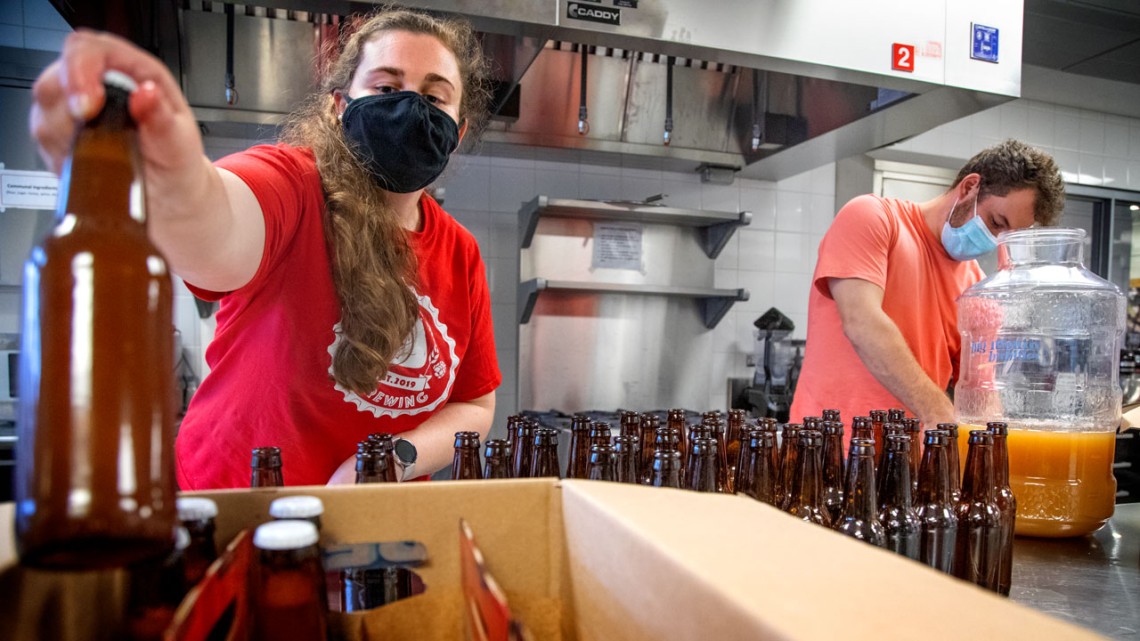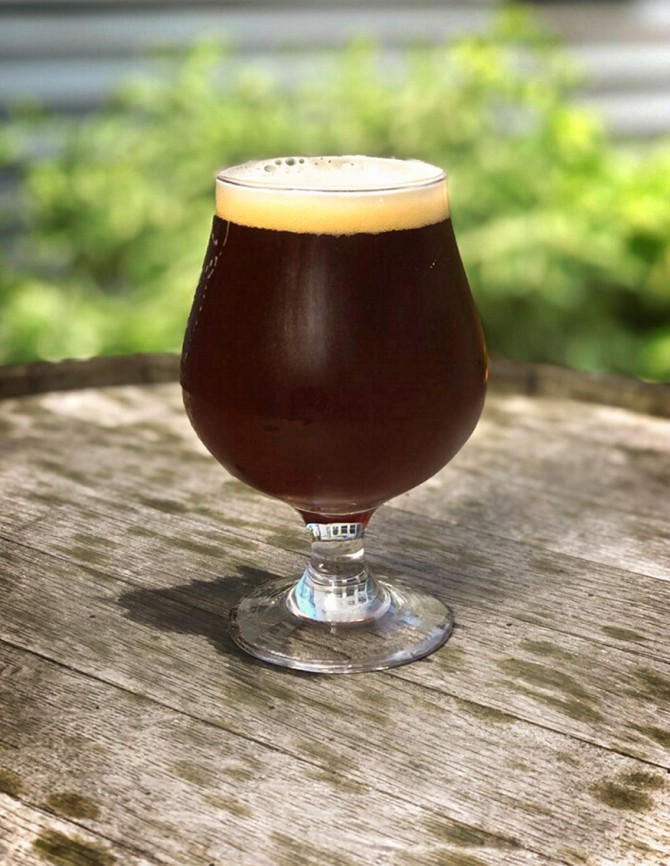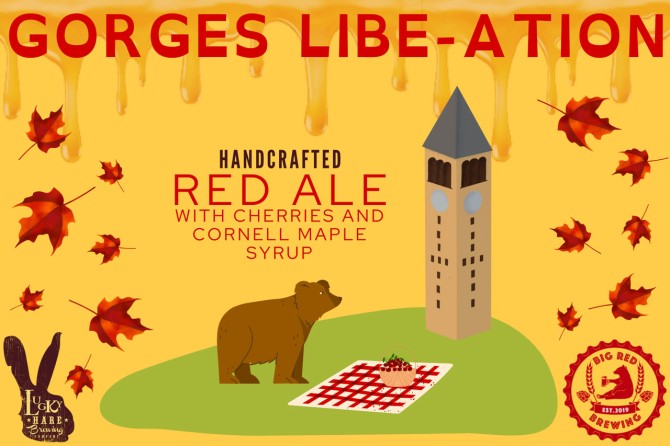
Margaux Mora, left, and Austin Montogomery, work to prepare another brew at the Food Product Innovation Lab, Stocking Hall.
Grad students brew Cornell-themed beer from NYS ingredients
By Blaine Friedlander
It’s got Finger Lakes hops, malt and cherries, plus maple syrup from the Arnot Forest and yeast cultured in a Stocking Hall food science lab. Add it all together, then let the magic of fermentation at a Seneca Lake brewery do the rest.
One taste of the Cornell graduate student-developed “Gorges Libe-ation” red ale and – you’ll love New York.
The new brew’s first pour is Oct. 22 at 4:30 p.m. at the Big Red Barn, adjacent to A.D. White House on campus.
“Gorges Libe-ation – a beer that we brewed at Lucky Hare Brewery – is an obvious nod to Ithaca’s gorges and a bow to Libe Slope,” said Margaux Mora, a doctoral student in food science. In her graduate work, Mora is investigating the sensory properties of natural sugar alternatives.
Mora helped found the Big Red Brewing graduate student organization, which is hosting the Oct. 22 event. (The new brew also will be available at the Regent Lounge in the Statler Hotel on campus and at Lucky Hare’s Ithaca and Hector, New York locations.)
“In our beer group, the idea of brewing a Cornell beer with all-New York ingredients has been floating around for a while,” she said. “Now with all the parts of this beer, it is indeed the fruit of local efforts.”
Pedersen Farm in Seneca Castle, New York, contributed the hops, while Wickham’s Tango Oaks Farm, Hector, New York, sent hundreds of pounds of sweet cherries. From Bloomfield, New York, in Ontario County, Murmuration contributed New York malt called Danko Rye. Finally, the Cornell Maple Program’s new facility at the Arnot Teaching and Research Forest in Van Etten, New York, sweetened the ale by providing top-tier maple syrup for the secondary fermentation.
The students selected an Omega Yeast Labs strain from the collection of Patrick Gibney, assistant professor of food science in the College of Agriculture and Life Sciences. The yeast – a British ale strain (OYL-014) cultured by doctoral student Glycine Jiang, who studies wine yeast – creates a clean, clear-bodied beer.
“This yeast strain is known to produce an especially balanced beer with full malt flavor,” Mora said.
Gathering at the Lucky Hare Brewery in early September, the students shoveled out malt, pitched the hops and left it to brew.
But the big question: What does the ale now taste like?
“It’s got a malt backbone,” said Ian Conboy, president of Lucky Hare Brewery. “You will find caramel, toffee and bready biscuit notes.”
The added cherries went through the “carbonic maceration” process, where the cherries ferment without oxygen present. Gorges Libe-ation has sweetness and tartness because of the cherries, Conboy said, and the ale leaves a classic, rich maple syrup flavor finish.
“It’s got a lot of body,” Conboy said. “It’s a sipper. This ale is quite filling and a fall weather beer for sure.”
Luck played a part: Douglass Miller, lecturer in food and beverage management Peter and Stephanie Nolan School of Hotel Administration, is one of the faculty advisers for the group. He coincidentally sat next to Lucky Hare Brewery’s Conboy during a Cornell function last spring. While conversing, they thought it might be fun for the Big Red Brewing group to work with Lucky Hare on a future project.
That future project became Gorges Libe-ation.
“This beer ties a lot of aspects of New York together,” said Miller, who teaches beverage and restaurant management, and a beer appreciation class. “This beer ties the many aspects that Cornell has to offer – the food science, the Nolan School, the beverage research in Geneva, the biology, the business of beverages.”
Miller said: “In its own way, this beer speaks to all the corners of the beer industry – and all corners of Cornell.”
In a recent tweet, fermentation expert Sam Alcaine, assistant professor of food science (CALS) – also one of the group’s faculty advisers – spoke for many people: “Can’t wait to enjoy a pint.”
In addition to Mora and Jiang, the graduate students who worked on Gorges Libe-ation:
• Margarita Valdiviezo (food science) earned a bachelor’s degree in food engineering in Peru, two masters in beverage technology in Germany, and has industry experience in Argentina;
• Austin Montgomery (food science), who studies flavor chemistry, is creating a beer now featuring a Beaujolais nouveau yeast, which he believes has never been put into a beer; and
• Christian Mercado (food science) who earned a bachelor’s degree in Puerto Rico, hosts a Spanish-language food engineering podcast, and is helping to develop maple syrup fermentation.
Get Cornell news delivered right to your inbox.
Subscribe


